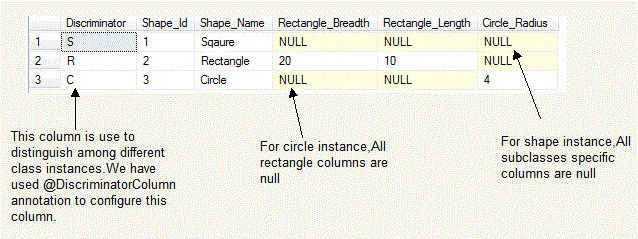This is 6 of 8 parts of tutorial series
Tutorial Content:
In this tutorial we will see how to implement inheritance in hibernate.There are 3 ways in which you can implement inheritance in hibernate.In this post,we will see one of them i.e.one table per class hierarchy.
Part-1:Introduction to hibernate framework
Part-2:Hibernate hello world example in eclipse
Part-3:Hibernate one to one mapping example
Part-4:Hibernate one to many mapping example
Part-5:Hibernate many to many mapping example
Part-6:Hibernate inheritance:Table per class hierarchy
Part-7:Hibernate inheritance:table per subclass
Part-8:Hibernate inheritance:Table per concrete class
Inheritance in hibernate:
Java is object oriented language and inheritance is one of main functionalities of java.Relation model can implement "is a" and "has a" relationship but hibernate provides us way to implement class hierarchy in a different ways.
One table per class hierarchy:
Lets say we have following class hierarchy.We have shape class as base class and Rectangle and Circle inherit from Shape class.
In one table per class hierarchy,One table will be created for above hierarchy.i.e. SHAPE table will be created having following structure.
As you can see only one table(SHAPE) is created having attributes of subclasses also.
As per our above class diagram,we will create three classes-Shape.java,Rectangle.java and Circle.java
Create Shape.java in src->org.arpit.javapostsforlearning.
Shape is our root class so some annotations needs to be used with root class for implementing inheritance.
Create Rectangle.java in src->org.arpit.javapostsforlearning.
As you can see only one table(SHAPE) is created having attributes of subclasses also.
As per our above class diagram,we will create three classes-Shape.java,Rectangle.java and Circle.java
1.Shape.java
This is our root class of entity class hierarchy.Create Shape.java in src->org.arpit.javapostsforlearning.
package org.arpit.javapostsforlearning;
import javax.persistence.Column;
import javax.persistence.DiscriminatorColumn;
import javax.persistence.DiscriminatorValue;
import javax.persistence.Entity;
import javax.persistence.GeneratedValue;
import javax.persistence.Id;
import javax.persistence.Inheritance;
import javax.persistence.InheritanceType;
import javax.persistence.Table;
import javax.persistence.DiscriminatorType;
@Entity
@Table(name="SHAPE")
@Inheritance(strategy=InheritanceType.SINGLE_TABLE)
@DiscriminatorColumn
(
name="Discriminator",
discriminatorType=DiscriminatorType.STRING
)
@DiscriminatorValue(value="S")
public class Shape {
@Id
@GeneratedValue
@Column(name="Shape_Id")
int shapeId;
@Column(name="Shape_Name")
String shapeName;
public Shape()
{
}
public Shape(String shapeName)
{
this.shapeName=shapeName;
}
//getters and setters
}
Shape is our root class so some annotations needs to be used with root class for implementing inheritance.
@Inheritance:
For implementing inheritance in hiberante,@Inheritance annotation is used.It defines inheritance strategy to be implement for entity class hierarchy.For one table per class hierarhcy,we have used Single_Table as inheritance strategy.This annotation is defined at root level or sub hierarchy level where different strategy is to be applied.
@DiscriminatorColumn:
This annotation is used to define discriminator column for Single_Table and joined strategy.It is used to distinguish between different class instances.This annotation is defined at root level or sub hierarchy level where different strategy is to be applied.
If @DiscriminatorColumn annotation is not specified,then hibernate will create a column named as "DType" and DiscriminatorType will be string.
@DiscriminatorValue:
This annotation defines value in discriminator column for that class.This can only be applied on entity concrete class.For example,If entry will be of shape instance in SHAPE table then "s" will be value for that row in discriminator column.If this annotation is not specified and Discriminator column is used then provider specific values will be provided and if Discriminator type is String then discriminator value will be entity name.Discriminator value,if not defaulted need to specified on each enitity in hierarchy.
2.Rectangle.java
This is our child class.Create Rectangle.java in src->org.arpit.javapostsforlearning.
package org.arpit.javapostsforlearning;import javax.persistence.Column;
import javax.persistence.Column;
import javax.persistence.DiscriminatorValue;
import javax.persistence.Entity;
@Entity
@DiscriminatorValue(value="R")
public class Rectangle extends Shape{
@Column(name="Rectangle_Length")
int length;
@Column(name="Rectangle_Breadth")
int breadth;
// getters and setters
public Rectangle()
{
}
public Rectangle(String shapeName,int length,int breadth)
{
super(shapeName);
this.length=length;
this.breadth=breadth;
}
// getters and setters
}
3.Circle.java
This is our second child class.
Create Circle .java in src->org.arpit.javapostsforlearning.
package org.arpit.javapostsforlearning;import javax.persistence.Column;
import javax.persistence.Column;
import javax.persistence.DiscriminatorValue;
import javax.persistence.Entity;
@Entity
@DiscriminatorValue(value="C")
public class Circle extends Shape{
@Column(name="Circle_Radius")
int radius;
public Circle()
{
}
public Circle(String shapeName,int radius)
{
super(shapeName);
this.radius=radius;
}
// getters and setters
}
4.Hiberante.cfg.xml:
Create a file named "hibernate.cfg.xml" in src folder.<?xml version='1.0' encoding='utf-8'?>
<!DOCTYPE hibernate-configuration PUBLIC
"-//Hibernate/Hibernate Configuration DTD 3.0//EN"
"http://hibernate.sourceforge.net/hibernate-configuration-3.0.dtd">
<hibernate-configuration>
<session-factory>
<!-- Database connection settings -->
<property name="connection.driver_class">com.microsoft.sqlserver.jdbc.SQLServerDriver</property>
<property name="connection.url">jdbc:sqlserver://localhost:1433;database=UserInfo</property>
<property name="connection.username">sa</property>
<property name="connection.password"></property>
<!-- JDBC connection pool (use the built-in) -->
<property name="connection.pool_size">1</property>
<!-- SQL dialect -->
<property name="dialect">org.hibernate.dialect.SQLServer2005Dialect</property>
<!-- Enable Hibernate's automatic session context management -->
<property name="current_session_context_class">thread</property>
<!-- Disable the second-level cache -->
<property name="cache.provider_class">org.hibernate.cache.NoCacheProvider</property>
<!-- Echo all executed SQL to stdout -->
<property name="show_sql">true</property>
<!-- Drop and re-create the database schema on startup -->
<property name="hbm2ddl.auto">create</property>
<mapping class="org.arpit.javapostsforlearning.Shape"></mapping>
<mapping class="org.arpit.javapostsforlearning.Rectangle"></mapping>
<mapping class="org.arpit.javapostsforlearning.Circle"></mapping>
</session-factory>
</hibernate-configuration>
5.Main Class:
package org.arpit.javapostsforlearning;
import org.hibernate.Session;
import org.hibernate.SessionFactory;
import org.hibernate.cfg.Configuration;
import org.hibernate.service.ServiceRegistry;
import org.hibernate.service.ServiceRegistryBuilder;
public class HibernateMain {
public static void main(String[] args) {
Shape shape=new Shape("Sqaure");
Rectangle rectangle=new Rectangle("Rectangle", 10, 20);
Circle circle=new Circle("Circle", 4);
Configuration configuration=new Configuration();
configuration.configure();
ServiceRegistry sr= new ServiceRegistryBuilder().applySettings(configuration.getProperties()).buildServiceRegistry();
SessionFactory sf=configuration.buildSessionFactory(sr);
Session ss=sf.openSession();
ss.beginTransaction();
ss.save(shape);
ss.save(rectangle);
ss.save(circle);
ss.getTransaction().commit();
ss.close();
}
}
Project structure:
6.Run it:
When you run it,you will get following output.
Hibernate: create table SHAPE (Discriminator varchar(31) not null, Shape_Id int identity not null, Shape_Name varchar(255), Rectangle_Breadth int, Rectangle_Length int, Circle_Radius int, primary key (Shape_Id))
Feb 04, 2013 11:01:36 PM org.hibernate.tool.hbm2ddl.SchemaExport execute
INFO: HHH000230: Schema export complete
Hibernate: insert into SHAPE (Shape_Name, Discriminator) values (?, 'S')
Hibernate: insert into SHAPE (Shape_Name, Rectangle_Breadth, Rectangle_Length, Discriminator) values (?, ?, ?, 'R')
Hibernate: insert into SHAPE (Shape_Name, Circle_Radius, Discriminator) values (?, ?, 'C')
7.SQL output:
SHAPE table in database.




No comments:
Post a Comment